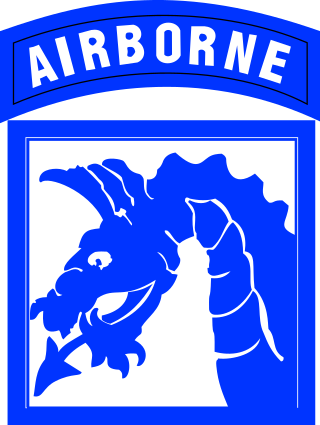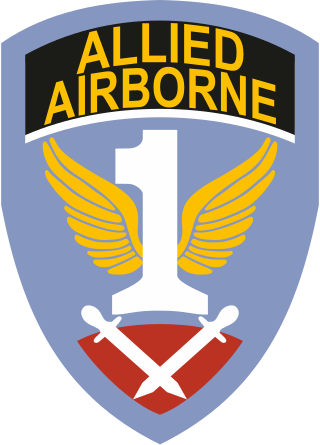
Airborne forces are ground combat units carried by aircraft and airdropped into battle zones, typically by parachute drop. Parachute-qualified infantry and support personnel serving in airborne units are also known as paratroopers.

The 101st Airborne Division (Air Assault) ("Screaming Eagles") is a light infantry division of the United States Army that specializes in air assault operations. It can plan, coordinate, and execute battalion-sized air assault operations to seize terrain. These operations can be conducted by mobile teams covering large distances, fighting behind enemy lines, and working in austere environments with limited or degraded infrastructure. For example, it was active in foreign internal defense and counterterrorism operations in Iraq, in Afghanistan in 2015–2016, and in Syria, as part of Operation Inherent Resolve in 2018–2021.

The 82nd Airborne Division is an airborne infantry division of the United States Army specializing in parachute assault operations into hostile areas with a U.S. Department of Defense mandate to be "on-call to fight any time, anywhere" at "the knife's edge of technology and readiness." Primarily based at Fort Liberty, North Carolina, the 82nd Airborne Division is part of the XVIII Airborne Corps. The 82nd Airborne Division is the U.S. Army's most strategically mobile division.

The XVIII Airborne Corps is a corps of the United States Army that has been in existence since 1942 and saw extensive service during World War II. The corps is designed for rapid deployment anywhere in the world and is referred to as "America's Contingency Corps." Its headquarters are at Fort Liberty, North Carolina.

The 13th Airborne Division was an airborne forces formation of division-size of the United States Army that was active during World War II. The division was commanded for most of its existence by Major General Elbridge G. Chapman. It was officially activated in the United States in August 1943 at Fort Bragg in North Carolina, remaining active until February 1946, however it never saw combat.

The 17th Airborne Division, "The Golden Talons", was an airborne infantry division of the United States Army during World War II, commanded by Major General William M. Miley.

Operation Varsity was a successful airborne forces operation launched by Allied troops toward the end of World War II. Involving more than 16,000 paratroopers and several thousand aircraft, it is the largest airborne operation ever conducted on a single day and in one location.
The Southwestern Front was a front of the Red Army during the Second World War, formed thrice.

The First Allied Airborne Army was an Allied formation formed on 2 August 1944 by the order of General Dwight D. Eisenhower, the Supreme Allied Commander of the Allied Expeditionary Force.

The 513th Parachute Infantry Regiment was an airborne infantry regiment of the United States Army, raised during World War II. The 513th formed part of the 17th Airborne Division and participated in the European Campaign, fighting in the latter stages of the Battle of the Bulge in January 1945 and parachuted into Germany in Operation Varsity in March, in the largest airborne drop of the war. The regiment returned to the United States in September 1945 where it was inactivated.

The 17th Cavalry Regiment is a historical organization within the United States Army that began as a regiment of cavalry after the Pancho Villa Expedition. The unit was constituted on 1 July 1916 in the Regular Army as the 17th Cavalry at Fort Bliss, Texas and originally inactivated 26 September 1921 at the Presidio of Monterey, California. Formerly a part of the 1950s Combat Arms Regimental System, it was reorganized as a part of the U.S. Army Regimental System, an ongoing effort to maintain the lineage and history of the U.S. Army through its units. Today, the 17th Cavalry Regiment is found across the army within the combat aviation brigades, where the squadrons, now constituted as attack/recon helicopter squadrons, carry on the legacy of the 17th Cavalry Regiment.

The 98th Guards Airborne Division is an airborne division of the Russian Airborne Troops, currently based in Ivanovo.

The 17th Parachute Engineer Regiment is heir to the traditions of the 17th Colonial Engineer Regiment which fought illustriously during the Second World War. It is the only airborne engineer unit of the French Army forming the engineering component of the 11th Parachute Brigade and secures all the specific airborne engineering missions relative to para assaulting at the level of deep reconnaissance as well as operations relative to para demining and handling explosives. The regiment has been present non-stop since 1975 on all theatres of operations. For its various combat operational deployments, the 17e RGP was cited 3 times at the orders of the armed forces, 2 times at the orders of the armed forces corps, and three of its combat companies cited at the orders of the armed forces in addition to armed forces corps.

The 125th Infantry Division was an infantry division of the Heer, the army of Nazi Germany, in World War II.

The 17th Parachute Battalion was an airborne infantry battalion of the Parachute Regiment, which was raised by the British Army during the Second World War.
The 40th Guards Rifle Division was one of a series of ten Guards rifle divisions of the Red Army formed from airborne troops in the spring and summer of 1942 in preparation for, or in response to, the German summer offensive. It fought in the Stalingrad area during that battle, eventually in the operations that encircled German 6th Army, and then continued to serve in the several campaigns in the south sector of the front, helping to liberate Ukraine and the Balkans, and ending the war at Vienna.

The 35th Guards Rifle Division was a division of the Soviet Red Army in World War II.
The 105th Guards Airborne Division was an airborne division of the Soviet Airborne Troops.

The 194th Glider Infantry Regiment was a Glider infantry regiment of the United States Army that served in World War II. It was a part of the 17th Airborne Division, and saw active combat service until its deactivation in 1945.
















